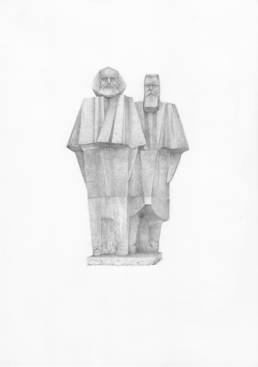Memento
2010–2017
Pencil on paper
Memento is a set of forty-one A4-sized pencil drawings, each representing a different statue in Memento Park, a “theme park” on the outskirts of Budapest. The park opened in 1993, gathering together the statues and plaques that had been placed on the city’s streets between 1947 and 1989, the years of Soviet rule. Hungary’s transition to independence was relatively peaceful, so aside from a 25m-high statue of Stalin (which was torn down) the monuments remained largely undamaged in the euphoria that came with the transferral of power. Some were removed from their sites by the new government, and some by individuals who worked at or near where the statues were located, and they were stored until the park was completed. Now on permanent display at Memento Park, they function primarily as a tourist attraction, but also for the purposes of education and nostalgia.
I visited the park in 2010 and made extensive photographic documentation of the exhibits, which I has used to produce the drawings. The drawn images appear to float in the middle of the page, free from locational context – they could be in the park, on the streets, or anywhere; they are simply themselves as images, movable and separable from each other. I made them intermittently between 2010 and 2016, and then sold them individually in 2017, such that the total revenue raised is exactly equal to the expenditure on the trip. The cost of the 2010 trip was £782.56, so the price of each drawing was £19.09.
Buyers were only permitted to purchase a single drawing from the set, and were not permitted to choose which one. A list of forty-one buyers was compiled and each was assigned a drawing at random. The drawings were not distributed until all forty-one were assigned to a buyer. Since the buyer had no control over which drawing they received, I predicted two potential scenarios in a buyer’s home when they received their drawing in the post: On one hand, the new owner would gain his/her pleasure from being an equal participant in the project rather than through seeking and obtaining a specific image from the set; he/she views all images as equally successful, equally desirable and therefore of equal value. On the other hand, the new owner had assigned different values to different drawings, leading to him/her being either particularly pleased or disappointed by what has been received; perhaps a statue of Lenin is a more desirable image than a Kalamár bust, but perhaps the bust is a superior drawing. Each potential outcome clashes with the other, the second possibly even generating a secondary market in which owners become traders, assigning their own values to each image in order to swap, sell or accumulate multiple images. The initial financial transaction remained symbolic, as there were no labour, material or space-rental costs built into the price, nor did the project take inflation into account; it was representative only of direct economic activity generated by the statues’ new context, i.e. what I spent on the infrastructure and apparatus required to see them in 2010.
I considered this project as an attempt to plot movement, and the change the movement represents. The monuments were made as Soviet propaganda, but were infused with Hungarian nationalism, as if the two were both compatible and desirable. They set the aesthetic agenda through their occupation of meeting places – sites of employment, government and leisure, and therefore played both a social and economic role. On the fall of the Soviet Union, their movement to the park reconfigured them for Hungarians and for foreigners – tourists from the former West no longer view them in opposition to their own aesthetic or political positions (they are now too otherworldly to be threatening) and locals view them as markers of change, either by their absence on the streets or through the distance from the aesthetic and political vernacular of contemporary Hungary (though this is shifting once again). As a site, Memento Park proposes a reversal: where once they were intended to intimidate visitors and galvanise locals, the statues now intend the opposite, to draw tourists from elsewhere, and to repel Hungarians. This project represents my own confrontation with the statues in their new economic form, and instigated a further set of movements that reflect the social and economic journeys the statues themselves have made since their production – their movement through physical, political and temporal space.








































